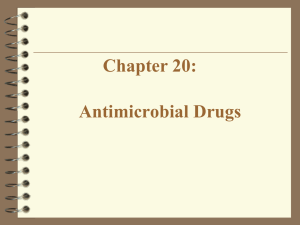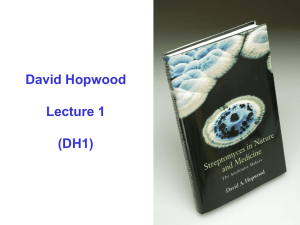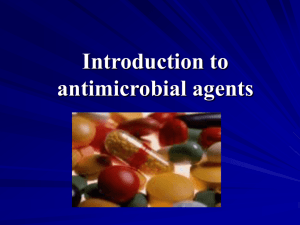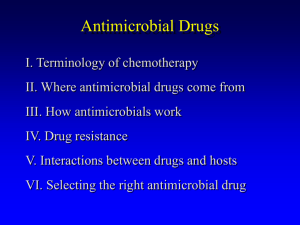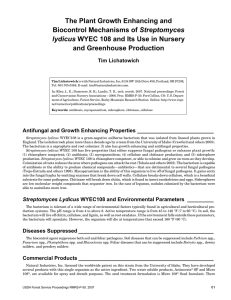Document 14111214
advertisement
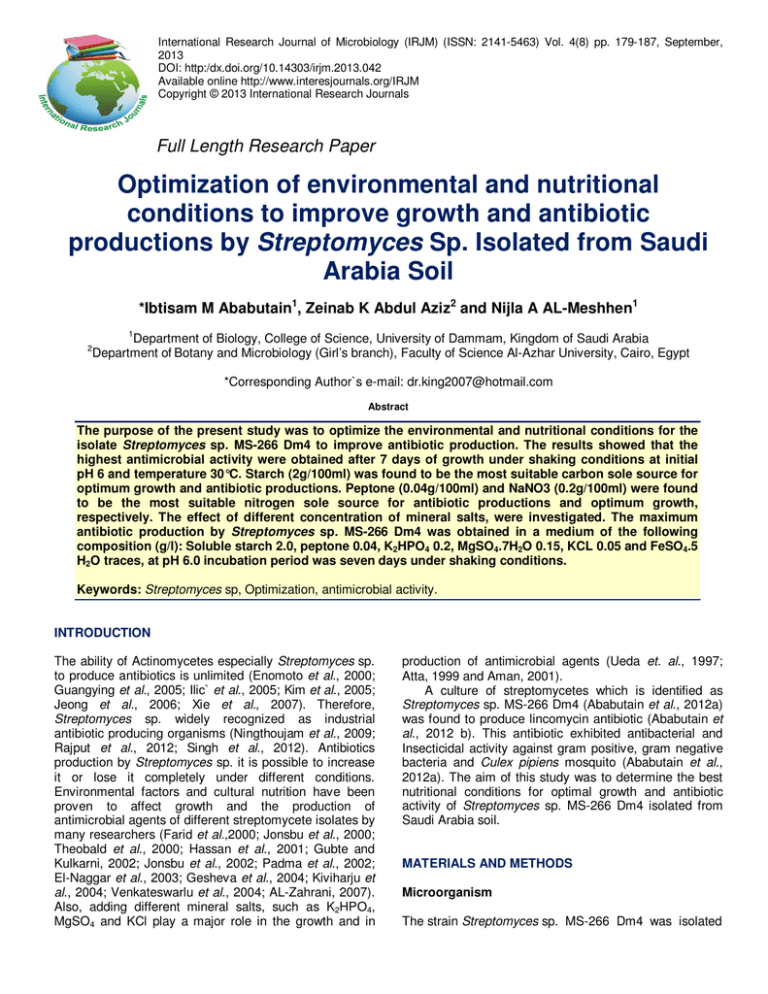
International Research Journal of Microbiology (IRJM) (ISSN: 2141-5463) Vol. 4(8) pp. 179-187, September, 2013 DOI: http:/dx.doi.org/10.14303/irjm.2013.042 Available online http://www.interesjournals.org/IRJM Copyright © 2013 International Research Journals Full Length Research Paper Optimization of environmental and nutritional conditions to improve growth and antibiotic productions by Streptomyces Sp. Isolated from Saudi Arabia Soil *Ibtisam M Ababutain1, Zeinab K Abdul Aziz2 and Nijla A AL-Meshhen1 1 Department of Biology, College of Science, University of Dammam, Kingdom of Saudi Arabia Department of Botany and Microbiology (Girl’s branch), Faculty of Science Al-Azhar University, Cairo, Egypt 2 *Corresponding Author`s e-mail: dr.king2007@hotmail.com Abstract The purpose of the present study was to optimize the environmental and nutritional conditions for the isolate Streptomyces sp. MS-266 Dm4 to improve antibiotic production. The results showed that the highest antimicrobial activity were obtained after 7 days of growth under shaking conditions at initial pH 6 and temperature 30°C. Starch (2g/100ml) was found to be the most suitable carbon sole source for optimum growth and antibiotic productions. Peptone (0.04g/100ml) and NaNO3 (0.2g/100ml) were found to be the most suitable nitrogen sole source for antibiotic productions and optimum growth, respectively. The effect of different concentration of mineral salts, were investigated. The maximum antibiotic production by Streptomyces sp. MS-266 Dm4 was obtained in a medium of the following composition (g/l): Soluble starch 2.0, peptone 0.04, K2HPO4 0.2, MgSO4.7H2O 0.15, KCL 0.05 and FeSO4.5 H2O traces, at pH 6.0 incubation period was seven days under shaking conditions. Keywords: Streptomyces sp, Optimization, antimicrobial activity. INTRODUCTION The ability of Actinomycetes especially Streptomyces sp. to produce antibiotics is unlimited (Enomoto et al., 2000; Guangying et al., 2005; Ilic` et al., 2005; Kim et al., 2005; Jeong et al., 2006; Xie et al., 2007). Therefore, Streptomyces sp. widely recognized as industrial antibiotic producing organisms (Ningthoujam et al., 2009; Rajput et al., 2012; Singh et al., 2012). Antibiotics production by Streptomyces sp. it is possible to increase it or lose it completely under different conditions. Environmental factors and cultural nutrition have been proven to affect growth and the production of antimicrobial agents of different streptomycete isolates by many researchers (Farid et al.,2000; Jonsbu et al., 2000; Theobald et al., 2000; Hassan et al., 2001; Gubte and Kulkarni, 2002; Jonsbu et al., 2002; Padma et al., 2002; El-Naggar et al., 2003; Gesheva et al., 2004; Kiviharju et al., 2004; Venkateswarlu et al., 2004; AL-Zahrani, 2007). Also, adding different mineral salts, such as K2HPO4, MgSO4 and KCl play a major role in the growth and in production of antimicrobial agents (Ueda et. al., 1997; Atta, 1999 and Aman, 2001). A culture of streptomycetes which is identified as Streptomyces sp. MS-266 Dm4 (Ababutain et al., 2012a) was found to produce lincomycin antibiotic (Ababutain et al., 2012 b). This antibiotic exhibited antibacterial and Insecticidal activity against gram positive, gram negative bacteria and Culex pipiens mosquito (Ababutain et al., 2012a). The aim of this study was to determine the best nutritional conditions for optimal growth and antibiotic activity of Streptomyces sp. MS-266 Dm4 isolated from Saudi Arabia soil. MATERIALS AND METHODS Microorganism The strain Streptomyces sp. MS-266 Dm4 was isolated 180 Int. Res. J. Microbiol. from Dammam, Saudi Arabia soil (Ababutain et al., 2012a). The test organism was Bacillus cereus. (K2HPO4, MgSO4.7H2O and KCL) were supplemented in different concentrations to basal production medium. Effect of the environmental condition RESULTS This includes the effects of incubation period, incubation temperatures and pH values. The dry weight was investigated and antimicrobial activity was tested by using the classical diffusion methods described by (Betina, 1983). Hundred ml of Starch nitrate broth medium were distributed among conical flasks with 250ml capacity. The flasks were sterilized, inoculated with 10 ml of Streptomyces sp. MS-266 Dm4 previously grown for 3 days in medium contained: yeast extract 10g, dextrose 10g, and tap water1000 ml with a pH of 6.8. Then, cultures were incubated at 30°C under static or shaken conditions separately. Cultures were removed at various intervals of incubation periods (3, 5, 7 and 9 days). After adjusting the incubation period the optimum growth temperature was studied. After inoculation, cultures were incubated at different temperatures (20-30-40-45- and 50° C). To study the effect of initial pH value, 100 ml aliquots of medium were adjusted to initial pH values (311), using 1N HCl or NaOH. At the end of incubation period, the dry weight and antibacterial activity were estimated. Effect of the environmental condition Effect of nutritional conditions This includes the effect of different carbon and nitrogen sources. Streptomyces sp. MS-266 Dm4 was initially grown in inoculation medium contained: yeast extract 10g, dextrose 10g, and tap water1000 ml with a pH of 6.8. The medium was sterilized, inoculated with Streptomyces sp. MS-266 Dm4 for 3 days at 30°C on a rotary shaker of 200 rpm. After growth 10 ml of Streptomyces sp. MS-266 Dm4 culture was transferred into the production medium contained the following components (g/100ml): starch 2.0, NaNO3 0.2, K2HPO4 0.1, MgSO4.7H2O 0.05, KCL 0.05 and FeSO4.5 H2O, traces. To study the influence the carbon sources different carbohydrates such as (glucose 2.1, galactose 2.1, fructose 2.1, maltose 2.0, sucrose 2.0, natural starch 2.3, and soluble starch 2.3) were added with equimolecular amount to the production medium in which starch was omitted. Influence of different concentrations of the best carbon source on the growth and antibacterial activity were estimated. Nitrogen sources (peptone 0.2, beef extract 0.3, (NH4)2SO4 0.155, KNO3 0.24 and urea 0.073) were added with equimolecular amount to the growth medium containing the optimal carbon source in suitable concentration, NaNO3 was omitted. Influence of various concentrations nitrogen source on the growth and antibiotic production was studied. The mineral salts Table (1) and figure (1) show that the maximum antimicrobial activity was attained after seven days of incubation under shake conditions. Streptomyces sp. MS266 Dm4 produced the antimicrobial agent after three days of incubation against gram positive bacteria (B. cereus), in which the inhibition zone size was (26 mm) under shaken conditions, while its (17 mm) under static conditions after five days of incubation. In addition, antimicrobial activity increased by increasing the incubation period up to seven days to rich 32mm in increase of 12.5%. The effect of incubation period on the dry weight under shaken condition was illustrated in (Table, 1). Table (2) and figure (2) show the relationship between antimicrobial activity, Dry weight and incubation temperatures. The incubation temperature 30°C was the best temperature for the growth and antimicrobial agent was produced by Streptomyces sp. MS-266 Dm4. The inhibition zone size was 32 mm against (B. cereus) followed by inhibition zone size (25, 19 mm) in 40°C and 45°C respectively. The less antimicrobial activity produced in incubation temperature 20°C in which the inhibition zone size was (15 mm). In incubation temperature 50°C the antimicrobial activity prevented. Table (3) and figure (3) show that the pH 6.0 is the most suitable pH values for the antimicrobial activity, which gave 28mm inhibition zone. Moreover, the pH 8.0 was the least values, which gave 20 mm inhibition zone. On other hand pH values used in this study (3-11) had less affect on the dry weight and it was between 0.3-0.5 g/100ml. Effect of nutritional conditions Effect of supplying certain nutritional requirements on the dry weight and productivity of antimicrobial agent by Streptomyces sp. MS-266 Dm4 was studied. Table (4) and figure (4) show the effect of adding different carbon sources on the dry weight and antimicrobial activity of Streptomyces sp. MS-266 Dm4 against B. cereus. The utilization of the tested carbon sources by isolate No. 4 for antibiotic production was found to be in the following descending manner: soluble starch = Glucose > fructose = galactose. In addition, the result shows that isolate No.4 can’t utilizes sucrose and maltose for antibiotic production. While, the natural starch prevents the antimicrobial activity and the growth. The highest dry weight appeared with the addition of soluble starch. Ababutain et al. 181 7 9 26 0.0 28 17 32 0.0 25 0.0 0.7 0.5 35 30 30 25 25 20 20 15 15 10 10 5 5 0 M e a n d i a m e te r o f i n h i b i ti o n z o n e (i n m m ) sh aken 5 Shaken Static Shaken Static Shaken Static Shaken Static Dry Weight (g/100ml) 0 0.9 3 5 7 9 Incubation period (days) 0.7 inhibition zone (mm) static Table (2) The effect of different incubation temperatures on the dry weight and productivity of antimicrobial agent by Streptomyces sp. MS266 Dm4 against B. cereus. Incubation ° temperatures ( C) Mean diameter of inhibition zone (mm) Dry Weight (g/100ml) 20 15 0.3 30 32 0.9 40 25 0.4 45 19 0.4 50 0.0 0.4 inhibition zone (mm) shaken Figure (2) The effect of different incubation temperatures (°C) on the dry weight and productivity of antimicrobial agent by Streptomyces sp. MS-266 Dm 4 against B. cereus. 35 1 0.9 0.8 0.7 0.6 0.5 0.4 0.3 0.2 0.1 0 30 25 20 15 10 5 0 20 30 40 45 Dry weight (g/ 100ml) 3 Mean diameter of inhibition zone (mm) Mean diameter of inhibition zone (mm) Incubation period(days) Figure (1) The effect of different incubation periods on the productivity of antimicrobial agent by Streptomyces sp. MS-266 Dm4 against B. cereus under shaken and static conditions. M e a n d i a m e te r o f i n h i b i ti o n z o n e (i n m m ) s ta tic Table (1) The effect of different incubation periods on the dry weight and productivity of antimicrobial agent by Streptomyces sp. MS266 Dm 4 against B. cereus under shaken and static conditions. 50 Incubation Temperatures mean diameter of inhibition zone (in mm) Table (5) and figure (5) show the effect of adding different concentrations of soluble starch on the dry weight and productivity of antimicrobial agents by Streptomyces sp. MS-266 Dm4 against B. cereus. The concentration 4.0 g/100ml was the best. Effects of supplying different nitrogen sources with different concentrations on the dry weight productivity of antimicrobial agent were studied. Among the nitrogen sources tested, the peptone was the best for the productivity of antimicrobial agent by Streptomyces sp. MS-266 Dm4 against B. cereus, Whereas NaNO3 was the best for the dry weight Table (6) and figure (6). The other nitrogen sources used in this study prevented the antimicrobial activity and reduced the dry weight. The dry weight (g/100ml) result showed that the Streptomyces sp. MS-266 Dm4 was able to grow without nitrogen sources, dry weight was 0.3 g/100ml. Among the concentration of peptone tested, 0.04g/100ml was the best concentration for the productivity of antimicrobial agent by Streptomyces sp. MS-266 Dm4 against B. cereus, whereas the concentrations (0.20 -0.45) g/100ml were the best for the dry weight, table (7) figure (7). The effect of supplying different concentrations of K2HPO4 is illustrated in figure (8) and table (8). It is obvious that maximum antibiotic production and dry weight was recorded in presence of 0.2 g/ 100ml. The effect of supplying different concentrations of MgSO4 is 182 Int. Res. J. Microbiol. 10 23 0.5 11 22 0.4 0.3 0.4 0.3 0.5 0.4 0.5 0.5 Mean diameter of inhibition zone (mm) Dry Weight (g/100ml) 30 0.6 25 0.5 20 0.4 15 0.3 10 0.2 5 0.1 0 0 3 4 5 6 7 8 9 Soluble Starch Glucose Galactose Fructose Sucrose Maltose Natural Starch Mean diameter of inhibition zone (mm) Dry Weight (g/100ml) 25 25 17 17 0.0 0.0 0.0 1.1 0.2 0.4 0.2 0.1 0.4 0.0 DISCUSSION Optimization environmental and nutritional conditions to improve antibiotic productions by Streptomyces Sp. dry weight (g/100ml) 30 1.2 25 1 20 0.8 15 0.6 10 0.4 5 0.2 0 0 Soluble Starch Glucose Galac tose Fructose Sucrose Maltose Natural Starch Carbon sources (g/100g) mean diameter of inhibition zone (in mm) illustrated in figure (9) and table (9). It is clear that maximum antibiotic production was recorded in presence of 0.15 g/100ml. However, the dry weight in lower concentrations of MgSO4 (0.05, 0.08) was higher by 1.7 %. The effect of supplying different concentrations of KCl is illustrated in figure (10) and table (10). It is clear that maximum antibiotic production and dry weight was recorded in presence of 0.05 g/ 100ml. 11 Figure (4) The effect of different carbon sources on the dry weight and productivity of antimicrobial agent by Streptomyces sp. MS-266 Dm4 against B. cereus. Mean diameter of inhibition zone (mm) Carbon sources (g/100ml) 10 Values of pH mean diameter of inhibition zone (in mm) Table (4) The effect of different carbon sources on the dry weight and productivity of antimicrobial agent by Streptomyces sp. MS-266 Dm4 against B. cereus. Dry weight (g/ 100ml) 3 4 5 6 7 8 9 Mean diameter of inhibition zone (mm) 25 25 26 28 21 20 25 Values of pH Figure (3) The effect of different pH values on the dry weight and productivity of antimicrobial agent by Streptomyces sp. MS-266 Dm4 against B. cereus. Dry weight (g/ 100ml) Table (3) The effect of different pH values on the dry weight and productivity of antimicrobial agent by Streptomyces sp. MS-266 Dm4 against B. cereus. dry weight (g/100ml) which was identified and found to produce lincomycin antibiotic (Ababutain et al., 2012 a,b) were estimated. Different environmental conditions such as pH, temperature and incubation period were studied. Adding different nutrients includes carbon, nitrogen sources and mineral salts in various concentrations were studied. Maximum growth and biosynthesis was occurred at the end of an incubation period of seven days on Starchnitrate agar medium. This result was identical to the results of (Hassan et al., 2001; Venkateswarlu et al., 2004; AL-Zahrani 2007). Whereas, five days incubation period was found to be the best by many researchers (Ryoo et al., 1997; Holtzel et al., 1998; Atta, 1999). In addition, EL-Naggar et al., (2003) were found that the Ababutain et al. 183 Table (5) The effect of different concentration of soluble starch on the dry weight and productivity of antimicrobial agent by Streptomyces sp. MS266 Dm4 against B. cereus. Free of N2 0.00 0.30 KNO3 0.00 0.20 Urea 0.00 0.20 (NH4)2SO4 0.00 0.10 2.5 3 3.5 4 4.5 5 Concentration of soluble starch (g/100g) mean diameter of inhibition zone (mm) dry weight (g/100ml) Figure (6) The effect of different nitrogen sources on the dry weight and productivity of antimicrobial agent by Streptomyces sp. MS-266 Dm4 against B. cereus 30 0.7 25 0.6 0.5 20 0.4 15 0.3 10 0.2 5 0.1 0 0 Dry weight (g/ 100ml) 0.30 2 re a 0.00 1.5 U Beef extract 0 1 (N H 4) 2S O 4 0.59 0 KN O 3 24 NaNO3 0.1 2 0.43 5 of N 26 0.2 Fr ee Dry Weight (g/100ml) 0.3 10 3 Mean diameter of inhibition zone (mm) 0.4 15 ex tr a ct Nitrogen sources (g/100ml) Peptone 0.5 20 aN O Table (6) The effect of different nitrogen sources on the dry weight and productivity of antimicrobial agent by Streptomyces sp. MS-266 Dm 4 against B. cereus. 0.6 25 D ry w eight (g/ 100ml) 0.39 0.52 0.59 0.55 0.55 0.49 0.49 0.48 0.41 0.7 Be ef 20 22 24 21 20.5 19.5 19 19 17 Mean diameter of inhibition zone (mm) Dry Weight (g/100ml) N 1.0 1.5 2.0 2.5 3.0 3.5 4.0 4.5 5.0 30 Pe pt on e Mean diameter of inhibition zone (mm) Mean diameter of inhibition zone (mm) Concentration of Soluble Starch (g/100ml) Figure (5) The effect of different concentration of soluble starch on the dry weight and productivity of antimicrobial agent by Streptomyces sp. MS266 Dm4 against B. cereus. Nitrogen sources (g/100g) mean diameter of inhibition zone (mm) highest productivity of MSW 2000 from S.violatus occurred after four days of incubation under static conditions. Our results agreed with the findings of many researchers (Aman, 2001; Hassan et al., 2001; Padma et al., 2002; Venkateswarlu et al., 2004) which found that the productivity increased in shaking culture comparing with the static culture this is due to the fact that streptomycetes are obligate aerobic organisms (Holt et al., 1994), while AL-Zahrani (2007) found that the shaking culture reduced the productivity of Streptomyces J12. dry weight (g/100ml) Maximum yield of the active metabolite produced by Streptomyces sp. MS – 266 Dm4 was obtained at an incubation temperature of 30° C and this result was agreed with many researchers (Gubte and Kulkarni, 2002; AL-khaldi, 2003 and Kiviharju et al., 2004). Also, Hassan et al., (2001) studied the effect of physiological factors on the productivity of antimicrobial material produced by S. violatus and they found that increasing the incubation temperature from 20 to 30°C led to increase growth and productivity of the antibiotic, while raising the temperature higher than 35°C has had an 184 Int. Res. J. Microbiol. Dry Weight (g/100ml) 0.39 0.40 0.40 0.40 0.41 0.43 0.43 0.43 0.43 0.43 0.43 Concentration of K2HPO4 (g/100ml) Mean diameter of inhibition zone (mm) Dry Weight (g/100ml) 0.025 24.7 0.52 0.05 25.3 0.55 0.1 27.3 0.56 0.15 27.3 0.56 0.2 0.25 30.7 21.3 0.61 0.59 0.3 20.7 0.59 35 0.44 30 0.43 25 0.42 20 0.41 15 0.4 10 0.39 5 0.38 0 0.37 0.03 0.04 0.05 0.1 0.15 0.25 0.3 0.35 0.4 0.45 Concentration of pepton (g/100g) mean diameter of inhibition zone (mm) dry weight (g/100ml) Figure (8) The effect of different concentration of K2HPO4 on the dry weight and productivity of antimicrobial agent by Streptomyces sp. MS-266 Dm 4 against B. cereus. 35 0.62 30 0.6 0.58 25 0.56 20 0.54 15 0.52 10 0.5 5 0.48 0 0.46 0.025 0.05 0.1 0.15 0.2 0.25 0.3 Concentration of K2HPO4 (g/100g) mean diameter of inhibition zone (mm) adverse effect on growth and productivity. Other study by Padma et al., (2002) recorded that the best incubation temperature was 29°C. In this study the maximum antibiotic activity was obtained at an initial pH 6.0. Other study by Crawford et.al., (1993) recorded that the best growth of actinomycetes strains were between pH 6.5-8 and few could not grow at pH 6.0, nevertheless the failure of a large number of actinomycetes to grow at pH 5.5. ELNaggar (1991) found that the initial pH value of the culture showed a significant influence on the maximum productivity of the antibiotic as well as on the growth of Streptomyces nasri. Our results are not in accordance with those obtained by Chattopadhyay and Sen (1997), 0.2 Dry weight (g/ 100ml) Table (8) The effect of different concentration of K2HPO4 on the dry weight and productivity of antimicrobial agent by Streptomyces sp. MS-266 Dm 4 against B. cereus. Mean diameter of inhibition zone (mm) Mean diameter of inhibition zone (mm) 29 30 29 26 26 26 22 21 21 17 17 Mean diameter of inhibition zone (mm) Concentration of Peptone (g/100ml) 0.03 0.04 0.05 0.10 0.15 0.20 0.25 0.30 0.35 0.40 0.45 Dry weight (g/ 100ml) Figure (7) The effect of different concentration of peptone on the dry weight and productivity of antimicrobial agent by Streptomyces sp. MS-266 Dm 4 against B. cereus. Table (7) The effect of different concentrations of peptone on the dry weight and productivity of antimicrobial agent by Streptomyces sp. MS-266 Dm 4 against B. cereus. dry weight (g/100ml) who noted that pH 7.0, is the most appropriate pH values to produce the highest amount of antibiotic of different types of Streptomyces. On the contrary, Holtzel et al., (1998) found the highest production at pH 5.5. In other research EL-Naggar et al., (2003) found that the highest amount of productivity of antibiotic by Streptomyces violatus at pH 7.5. Our result showed that maximum growth and antibiotic production was obtained in cultures supplemented with 2.0g /100ml soluble starch as a sole carbon source. Cultures containing sucrose, maltose or natural starch did not yield any detectable amounts of the antibiotic. Other researcher (EL-Naggar, 1991; Haque et al., 1995 and Theobald et al., 2000) supports this. In Ababutain et al. 185 Figure (9) The effect of different concentration of MgSO4 on the dry weight and productivity of antimicrobial agent by Streptomyces sp. MS-266 Dm4 against B. cereus. 0.05 32.7 0.59 0.08 32.7 0.59 0.1 34 0.55 0.58 0.15 36 0.58 0.2 32.7 0.53 0.6 0.59 36 0.58 35 0.57 0.56 34 0.55 33 0.54 0.53 32 0.52 31 0.51 30 0.5 0.02 0.05 0.08 0.1 0.15 1.0 1.5 Mean diameter of inhibition zone (mm) 20 22 dry weight (g/100ml) Figure (10) The effect of different concentration of KCl on the dry weight and productivity of antimicrobial agent by Streptomyces sp. MS-266 Dm 4 against B. cereus. 30 Dry Weight (g/100ml) 0.39 0.52 2.0 24 0.59 2.5 21 0.55 3.0 3.5 20.5 19.5 0.55 0.49 4.0 19 0.49 4.5 5.0 19 17 0.48 0.41 addition, many researchers found that starch is the best carbon source for the highest productivity of the active substance but in different concentration. Al-Khaldi (2003) found that the best concentration was 3.0g/100ml while, AL-Zahrani (2007) found that the best concentration was10gm / L. In contrast, Haque et al., (1995) found that glycerol was the most suitable carbon source for production of S. antibioticus. Gesheva et al., (2004) explained that there is a significant effect in the case of replacement of glucose by glycerol or lactose in the production of anti-bio-macrolide AK-111-81. Venkateswarlu et al., (2004) confirmed increasing the productivity of rifamycin in the presence of glucose as a Mean diameter of inhibition zone (mm) Concentration of Soluble Starch (g/100ml) 0.2 Concentration of MgSO4 (g/100g) mean diameter of inhibition zone (mm) Table (10) The effect of different concentration of KCl on the dry weight and productivity of antimicrobial agent by Streptomyces sp. MS-266 Dm 4 against B. cereus. Dry weight (g/ 100ml) 0.02 Dry Weight (g/100ml) Mean diameter of inhibition zone (mm) 37 Mean diameter of inhibition zone (mm) 32 Concentration of MgSO4 (g/100ml). 0.7 0.6 25 0.5 20 0.4 15 0.3 10 0.2 5 Dry weight (g/ 100ml) Table (9) The effect of different concentration of MgSO4 on the dry weight and productivity of antimicrobial agent by Streptomyces sp. MS-266 Dm4 against B. cereus. 0.1 0 0 1 1.5 2 2.5 3 3.5 4 4.5 5 Concentration of soluble starch (g/100g) mean diameter of inhibition zone (mm) dry weight (g/100ml) source of carbon. Among the six nitrogen sources tested, the peptone in concentration of 0.04g/l00ml was preferable to the antibiotic production whereas NaNO3 was preferable to the growth. These results are in partial agreement with (Atta, 1999). Otherwise, EL-Naggar (1991) and Aman (2001) found that sodium nitrate was the most appropriate source of nitrogen. Theobald et al., (2000) noted the increase in the production of antibiotic extracted from S. antibioticus with the presence of lysine as a source of nitrogen. Gesheva et al., (2004) found that the addition of ammonium succinate increase productivity of macrolide Ak-111-81. Venkateswarlu et al., (2004) 186 Int. Res. J. Microbiol. recorded in their study that the ammonium sulphate, soybean and peanuts were the best sources of nitrogen to increase the productivity of rifamycin. The effect of adding different concentrations of mineral salts was varied. We found that the concentration of (KCl) 0.05 g/100ml increase the productivity and dry weight which was similar to the concentration in the basic medium and consistent with the results of Aman (2001). While the concentration of (K2HPO4) and (MgSO4) increased than in the basic medium. The results showed that there is a close relation between increased concentration of (K2HPO4) and (MgSO4) and increase in the productivity of the active substance. Similar results were mentioned by (Ueda et. al., 1997; Atta, 1999 and Aman, 2001) who made it clear that the addition of different concentrations of mineral salts to the growth media of Streptomyces have a positive effect on growth and productivity of antibiotic. Farid et al., (2000) found that 0.05g / lL (K2HPO4) is the best concentration for the production of active substance by Streptomyces natalensis. Also they found that increasing the concentration of phosphate in the growth media leads to a significant increase in biomass associated with a decrease in the productivity of the active substance. ElNaggar (1991) explained that the salts of magnesium and potassium are considered the most appropriate salts for the growth of Streptomyces, as well as the production of active substance. The effects of magnesium availability are presumably due to requirements of this action for protein synthesis, and its depletion may restrict enzyme synthesis and activity (Aasen et al. 1992; Natsume et al. 1994). CONCLUSION Antibiotic productivity of Streptomyces isolate is inconstant, and could be increased, decreased or loses significantly under different nutritional conditions. Therefore, modified quantities and use different sources of carbon, nitrogen and mineral salts, as well as changing the growing conditions is one of the fundamentals that must be followed when studying the production of antibiotics from these organisms. The present study clearly found that there are no clear relationship between biomass and antibiotic activity. REFERENCES Aasen IM, Folkvord K, Levine DW (1992). Development of a process for large- scale chromatographic purification of an alginate lyase from Klebsiella pneumoniae. J. Appl. Microbiol. Biotechnol. 37: 55-60. Ababutain, IM, Abdul Aziz ZA, AL-Meshhen NA (2012a). Lincomycin Antibiotic Biosynthesis Produced by Streptomyces Sp. Isolated from Saudi Arabia soil: I- Taxonomical, antimicrobial and insecticidal studies on the producing organism. Can. J. Pure and Appl. Sci. 6(1):1739-1748. Ababutain IM, Abdul Aziz ZA, AL-Meshhen NA (2012b). Lincomycin Antibiotic Biosynthesis Produced by Streptomyces Sp. Isolated from Saudi Arabia soil: II- Extraction, separation and purification of Lincomycin. Can. J. Pure and Appl. Sci. 6(2):1905-1911. Al- Khaldi EMUA (2003). Microbiological studies on some Streptomycetes isolated from the soil of the eastern province of the kingdom of Saudi Arabia. M. Sc. Thesis. Botany and Microbiology Department. Girls Science College. Dammam. Kingdom of Saudi Arabia. AL-Zahrani S (2007). Studies on the antimicrobial activity of Streptomyces sp. isolated from Jazan. J.Kau, Sci.19:1-186. Aman GZ (2001). Studies on some actinomycete isolates from certain desert soil samples. PhD Thesis. Faculty of Science. Al-Azhar University, Egypt. Atta HM (1999). Application of Biotechnology in the Search for Antibiotics from Environmental Pollutants under Solid State Fermentation Conditions. Ph.D. Thesis. Faculty of Science. AIAzhar University. Egypt. Betina V (1983). The chemistry and biology of antibiotics. Elsevier Scientific Publishing Company Inc, Amsterdam, New York. Chattopadhyay D, Sen SK (1997). Optimization of cultural conditions for antifungal antibiotic accumulation by Streptomyces rochei G164. Hindustan. Antibiot. Bull. 39 (1-4): 64 - 71. Crawford DL, Lynch JM, Whipps JM, Ousley MA (1993). Isolation and characterization of Actinomycete antagonists of a Fungi root pathogen. Applied and Environmental Microbiology, 59 (11): 3 899905. El-Naggar MY (1991). Antibiotic production by some mutants of Streptomyces nasri. M.Sc. Thesis. Faculty of Science Alexandria University. Egypt. El-Naggar MY, Hassan MA, Said WY, El-Aassar SA (2003). Effect of support materials on antibiotic MSW2000 production by immobilized Streptomyces violatus. J. Gen. Appl. Microbiol. 49 (4): 235-43. Enomoto Y, Shiomi K, Matsumoto A, TakahashiY, Iwai Y, Harder A, KöLBL H, Woodruff HB, Ōmura S (2000). Isolation of anew antibiotic OligomycinG produced by Streptomyces sp. WK-6150. J. Antibiot. 54 (3): 308-313. Farid MA, El-Enshasy HA, el-Diwany AL, El-Sayed SA (2000). Optimization of the cultivation medium for natamycin production by Streptomyces natalensis. J. Basic. Microbiol. 40(3): 157 - 166. Gesheva V, Ivanova V, Gesheva R (2004). Effects of nutrients on the production of AK-111-81 macrolide antibiotic by Streptomyces hygroscopicus . Microbiological. 160(3): 243-248. Guangying C, Birun L, Yongcheng L, Fengchun X, Wen L, Wang-Fun F (2005). A New Fungicide Produced by a Streptomyces sp. GAAS7310. J. Antibiot, 58(8): 519–522. Gubte MD, Kulkarni PR (2002). A study of antifungal antibiotic production by Streptomyces chattanoogensis MTCC3423 using full factorial design. Literature Appl. Microbiology, 35(7): 6-22. Haque SF, Sen SK, Pal SC (1995). Nutrient optimization for production of broad spectrum antibiotic by Streptomyces antiboticus SRI5. 4. Acta. Microbiol. Immunol. Hung. 42 (2):155-162. Hassan M, EL-Naggar M, Said W (2001). Physiological factors affecting the production of an antimicrobial substance by Streptomyces violatus in batch culture. Egyptian J. of Biology. 3:1-10. Holt JG, Krieg NR, Sneath PHA, Staley JT, Williams ST (1994). Bergey's Manual of Determinative Bacteriology (9th ed.). Williams & Wilkins, Maryland Baltimore, USA. Holtzel A, Kempter C, Metzger JM, Jung G, Groth I, Fritz T, Fiedler HP (1998). Spirofungin, a new antifungal. J. Antibiot. 51(8):699-707. Ilic` SB, Konstantinovic` SS, Todorvic ZB, (2005). UV/VIS analysis and antimicrobial activity of Streptomyces isolates. Medicine and Biology. 12(1):44-46. Jeong SY, Shin HJ, Kim TS, Lee HS, Park SK, Kim HM (2006). Streptokordin, a new cytotoxic compound of the methyl pyridine class from a marine- derived Streptomyces sp. KORDI- 3238. J. of Antibiotic, Japan. Jonsbu E, Ellingsen TE, Nielsen J (2000). Effects of nitrogen sources on cell growth and production of nystatin by Streptomyces noursei. J. Antibiot. 53(12): 1354 -1362. Jonsbu E, Mclntyre M, Nielsen J (2002). The Influence of carbon sources and morphology on nystatin production by Streptomyces nousei. J. Biotechnol. 95(2): 133 -144. Ababutain et al. 187 Kim BS, Oh H, Kim SY, Park JA, Yoon YJ, Lee SK, Kim BY, Ahn JS (2005). Identification and antibacterial activity of anew Oleandomycin derivative from Streptomyces antibioticus. J. Antibiot. 58(3): 196-201. Kiviharju K, Leisola M, Eerikainen T (2004). Optimization of Streptomyces peucetius var. caesius N47 cultivation and erhodomycinone - production using experimental designs and response surface methods. J. Industrial Microbiol. Biotechnol. 31(10):475-481. Natsume M, Kamo Y, Hirayama M, Adachi T (1994). Isolation and characterization of alginate-derived oligosaccharides with roof growth-promoting activities. Carbohydrates Research 258: 187-197. Ningthoujam D, Sanasam S, Nimaichand S (2009). A Streptomyces sindenensis strain LS1-128 exhibiting broad spectrum antimicrobial activity. J. Biol. Sci. 4(10):1085-1091. Padma PN, Rao AB, Yadav JS, Reddy G (2002). Optimization of fermentation conditions for production of glycopeptide antibiotic vancomycin by Amcolatopsis orientalis. Appl. Biochem. Biotechnol. 102-103 (1-6): 395 - 405. Pandey B, Ghimire P, Agrawal VP (2004). Studies on the antibacterial activity of the Actinomycetes isolated from the Khumbu Region of Nepal. J. Biol. Sci. 23:44-53. Rajput Y, Biswas J, Rai V (2012). Potentiality test in antimicrobial activity and antibiotic sensitivity of subterranean streptomyces strain isolated from Kotumsar cave of India. Int. J. Biol. Chem. 6: 53-60. Ryoo IJ, Song KS, Kim JP, Kim WG, Koshina H, Yoo ID (1997). Anew cytotoxic phenylthial-iazoline, 4-methylaeruginoic acid from Streptomyces sp. KCT9303. J. Antibiot. 50(3): 256-258. Singh AP, Singh RB, Mishra S (2012). Microbial and biochemical aspects of antibiotic producing microorganisms from soil samples of certain industrial area of India- an Overview. The open Nutraceuticals J. 5:107-112. Theobald U, Schimana J, Fiedler HP (2000). Microbial growth and production kinetics of Streptomyces antibioticus Tu 6040. Antonie. Van. Leeuwenhoek. 78(3-4): 307 - 313. Ueda K, Tomaru Y, Endoh K, Beppu T (1997). Stimulatory effect of copper on antibiotic production and morphological differentiation in Streptomyces tanashiensis. J. Antibiot. 50 (8): 693 - 695. Venkateswarlu G, Murali Krishna, PS, Venkateswar Rao L (2004). Production of Rifamycin using Amycolatopsis mediterranei (MTCC 14). Bioprocess and Biosystems Engineering, 20(1): 27-30. Xie Y, Chen R, Si S, Sun CH, Xu H (2007). A new nucleosidyl-peptide antibiotic, Sansanmycin. J. Antibiot. 60(2):158-161. How to cite this article: Ababutain IM, Aziz ZKA and AL-Meshhen NA (2013). Optimization of environmental and nutritional conditions to improve growth and antibiotic productions by Streptomyces Sp. Isolated from Saudi Arabia Soil. Int. Res. J. Microbiol. 4(8):179-187

